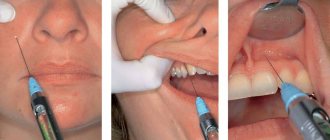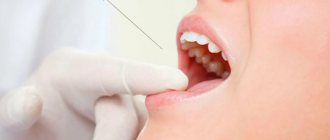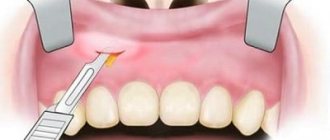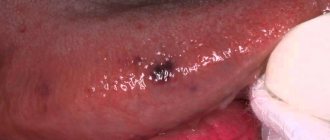Anesthesia during dental treatment is the main achievement of modern dentistry. Without local anesthesia, only the removal of superficial caries is carried out without affecting the pulp. If the patient is terrified of medical intervention, dental procedures are performed under general anesthesia. The article will cover the question of what torus anesthesia is and in what cases it is used.
Anatomical features
The mandibular ridge is formed from two bone cords of the coronoid and condylar processes, which are located above and in front of the bone uvula. Along the slopes of this formation there are three nerve endings that lose sensitivity. Thanks to this effect, sensitivity in the area from the second premolar to the second molar in the middle is impaired, which makes it possible to painlessly carry out dental procedures and operate on problem areas of the oral cavity.
What are the indications for Go-Gates anesthesia?
Cases for using this technique
The use of torusal anesthesia is possible in the following cases:
- opening boils, abscesses, phlegmon and other purulent formations inside the oral cavity;
- carrying out surgical interventions in the area of the dentition of the lower jaw;
- removal of incorrectly formed teeth, as well as in case of defects in location;
- removal of wisdom teeth;
- applying splints for a fracture of the lower jaw;
- depulpation;
- surgical manipulations to remove cysts, tumors and mutilated bone parts in the mandibular region.
What is torusal anesthesia
Methods of pain relief during dental procedures are selected depending on the type of intervention performed and the characteristics of the clinical picture. This can be either an injection of an anesthetic into the gum (infiltration) or covering a large area of the patient’s face - conduction anesthesia. With conduction anesthesia, a bundle of nerves that transmit pain sensations to the brain is blocked.
Since there are several nerves in the oral cavity, the impact is carried out specifically on the tooth adjacent to the diseased tooth. Thus, when treating molars of the lower jaw, mandibular anesthesia is performed, a variation of which is the torus method of anesthesia. With this method of pain relief, the mandibular nerves are blocked:
- inferior alveolar;
- buccal;
- lingual.
An anesthetic solution is injected into the junction point of these nerves - the torus. As a result of infiltration of the solution, complete anesthesia of the following facial areas occurs:
- chin;
- soft tissues of the lower jaw;
- their corresponding skin.
That is, sensitivity is lost at the level of the skeletal and muscular systems, as well as the skin. The effectiveness of pain relief allows you to begin medical procedures almost immediately after instillation of the product.
The advantage of the technique is that there is a large area of the facial region that is insensitive to pain. Disadvantages are the possibility of complications after the injection and the presence of a highly qualified dentist. The doctor must have knowledge of anatomical landmarks in order to find the right point for instillation without mistakes.
Painkillers used:
- lidocaine;
- ultracaine;
- novocaine
- trimecaine.
For serious surgical interventions that require a long time, other medicinal substances with an analgesic effect are used. Trimecaine is used to remove lower molars; it effectively blocks the dental nerves. It is also used for cleaning canals and filling teeth affected by caries.
If the chewing molars remain insensitive to the action of the medicine after the injection, the dentist performs additional anesthesia: saturates the mucous membrane around the sensitive molars with the solution.
What happens?
According to the description of anesthesia according to Gough-Gates, before it is performed, the patient must open his mouth as wide as possible. When not fully opened, the lower jaw can move around the frontal axis. The articular disc is located in the articular fossa, and the mandibular foramen moves backward and downward. As a result, the mandibular nerve begins to stretch between the mandibular and foramen ovale. That part of it, which is connected with the mandibular foramen, shifts somewhat closer to the temporomandibular joint.
At the second stage, with further opening of the mouth against the background of the hinge movement of the articular head in the lower floor of the joint, the cartilaginous discs, together with the heads of the condylar process, slide forward and emerge onto the articular tubercle.
In the process of further maximum lowering of the lower jaw, movement is observed only in the lower level of the joint along the frontal axis. Thus, the closest location of the mandibular nerve and the target point occurs already at the second stage, when the head of the condylar process moves forward onto the articular tubercle. Subsequent maximum opening of the mouth is not advisable. The process of transition of the condylar process forward is easily determined, while the head is palpated somewhat better, which satisfies the basic position.
When to use
The effectiveness and simplicity of torusal anesthesia allows it to be used in many cases of dental practice.
Torusal anesthesia is used for:
- opening of ulcers and abscesses in the lower jaw;
- extraction of mandibular molars;
- depulpation and other methods of intervention;
- installation of fixing splints in case of injury to the mandibular region;
- removal of molars with abnormal root locations;
- surgery for broken jaw bones;
- elimination of neoplasms;
- augmentation/removal of the jawbone.
Pain relief is also carried out in case of abnormal eruption of wisdom teeth, which is accompanied by severe swelling and pain. Incorrect growth of a wisdom tooth can cause rupture of gum tissue and cause severe complications.
The effectiveness of instillation depends on the qualifications of the dentist. To simultaneously block three nerves, you need to accurately hit the point of their connection, which is located in the torus. If the doctor cannot correctly determine the location of the torus, then it will not be possible to numb the desired area of the lower part of the face.
Incomplete pain relief can lead to discomfort during dental procedures. If the patient feels that there is insufficient blockage of the facial nerves, he should immediately inform the dentist.
Anesthetics used in this method may cause allergic reactions. Therefore, you need to warn your dentist about intolerance to certain medicinal components.
Allergic reactions to drugs are another problem with anesthesia. Since quite a large number of patients are intolerant to certain substances, pain relief can cause an unpredictable reaction in the body.
Types of technology
Torusal anesthesia is carried out using several techniques:
- according to Go-Gates;
- according to Legardi;
- according to Akinozi-Visari.
In addition, the anesthetic can be administered using the apodactylic technique or extraorally.
Go-Gates anesthesia was developed in 1973 by Australian dentist Go-Gates. The technique for performing pain relief is quite complex, but it is endowed with specific guidelines and is effective in 97% of cases. The peculiarity of this technique lies in the change in the relative position of the destination for the anesthetic substance and the mandibular nerve with the necessary opening of the mouth. During the opening process, the lower jaw rotates along the frontal axis in the same articular tier, as a result of which the head of the condylar process, with the help of a cartilaginous disc, begins to move forward onto the articular eminence.
The described anesthesia according to Gou-Gates in dentistry does not require careful visual control and the construction of a spatial image. It is successfully carried out in the presence of moderate coordination of movements, similar to the information with closed eyes of the index fingers of two hands.
Thus, an analysis of the features of this method of local anesthesia of the mandibular nerve using the Gou-Gates mechanism explains its safety and effectiveness, and also allows us to clarify a number of provisions in the technique of its implementation.
Bottom line
Torusal anesthesia is an effective means for quickly numbing a large area of the facial area. It is performed during complex dental procedures, when it is necessary to numb a large area of the facial region for a long time. With one injection, it is possible to immediately block three facial nerves that react acutely to pain.
However, performing the manipulation requires high medical qualifications, knowledge of the anatomy of the location of nerve endings, and careful handling of instruments. Improper administration of a drug can lead to various complications and injure the patient. The technique is used when other methods of blocking nerve endings are ineffective.
Sources used:
- Basic methods of pain relief at an outpatient dental appointment / Samedov Timur Islamovich. - M.: SpetsLit, 2011.
- Local anesthesia in dentistry / E.A. Bazikyan. - M.: GEOTAR-Media, 2012.
- Therapeutic dentistry. Anesthesia. Bleaching. Filling. Endodontics / Edited by E.V. Borovsky. - M.: Dentistry, 2005.
Disadvantages and advantages
Positive aspects of the technique of torsal anesthesia according to Gou-Gates:
- high efficiency from 90 to 98%;
- insignificant degree of possible negative consequences;
- clear definition of guidelines.
The main disadvantage of this anesthesia technique is the long period of time to achieve the effect, approximately 5 minutes longer than when using other methods of anesthesia.
Contraindications for carrying out
In what cases is local anesthesia of the oral cavity contraindicated or has partial contraindications? Anesthesia is prohibited for any liver pathologies, as it directly affects liver cells. Due to the high dose of novocaine, this method is excluded from the permissible method, and general anesthesia is recommended instead.
Also, torusal anesthesia is contraindicated for:
- intolerance to the components of the medicinal substance;
- pathologies of the circulatory system;
- mental disorders;
- bronchial asthma;
- cardiovascular pathologies;
- epileptic seizures.
Also, local anesthesia of this method is not carried out in case of anatomical disorders in the structure of the jaw and gums, as well as when the point of connection of the nerves is shifted.
Can this anesthesia be used during pregnancy? Permission must be given by the treating gynecologist, since the method may pose a certain danger to the fetus.
Technique for blocking the inferior alveolar nerve
In such a case, sensitivity from the following nerves decreases:
- reed;
- lower alveolar;
- maxillohyoid;
- buccal;
- auricular-temporal.
The step-by-step instructions are as follows:
- The patient is positioned in a semi-horizontal or horizontal position, which is not only convenient for anesthesia using the Go-Gates method, but also the most physiological for the prevention of emergency conditions in the patient due to various reflex disorders of the tone of blood vessels. The specialist is placed on the right side of the patient.
- The most accurate location of the doctor will be determined by which side of the patient is supposed to be anesthetized. In this case, the patient's head should be asked to turn slightly away from the dentist due to similar considerations.
- With the patient's mouth open, the mucous membrane at the site of the intended injection in the pterygomaxillary recess is processed, initially drying and then anesthetizing with topical anesthetic. The drug is applied pointwise under Gou-Gates anesthesia, and after 2-3 minutes its residues should be eliminated.
- Additional techniques to reduce tissue trauma and prevent vascular reactions during injection may be the following: before piercing the mucous membrane, the patient is asked to take a deep breath and hold his breath for a short time, which helps reduce the number of possible unwanted movements of the patient as the needle moves to its destination . Additional pre-ventilation of the lungs during the period of deep inspiration helps to increase blood oxygen saturation and will, as a rule, lead to a slight increase in heart rate as a result of the cardiorespiratory reflex, which increases blood flow to the blood vessels.
- The specialist takes the syringe in his right hand, places it in the corner of the oral cavity opposite the side of the injection, retracting the tissue of the buccal mucosa on the side of the injection with the thumb, which is placed in the mouth. After this, the dentist asks the patient to open his mouth wide, controlling the level of its opening along the exit to the articular tubercle of the condylar process, the movement of which, as already described, can be traced by feeling under the index finger placed in the external auditory canal or in front of the tragus. The needle is directed to the pterygomaxillary zone, the medial tendon of the temporal muscles to the area where application anesthesia was previously administered.
- After the patient holds his breath, a puncture is made to the mucous membrane, and the needle is slowly advanced until it stops in the bone tissue - the lateral sections of the condylar process, behind which the tip of the index finger is located. Reaching the bone should correspond to the location of the needle tip at its destination. If this does not happen, the needle begins to be slowly withdrawn to the surface of the mucosa, its orientation is corrected and the advancement is repeated.
- If the target point is successfully reached, the needle is retracted 1 mm back and an aspiration test is performed. If the results of this test are negative, 1.7-1.8 ml of anesthetic solution is slowly injected, while the specialist’s attention should be focused on the patient’s condition.
- After administering the anesthetic, the needle is slowly withdrawn from the tissue. After the injection, the patient is asked not to close his mouth for another 2-3 minutes so that the local anesthetic substances permeate the surrounding tissues in the anatomical location that they have when the mouth is opened. In most cases, this type of anesthesia also blocks the buccal nerve. It is very advisable to additionally anesthetize the buccal nerve before surgery, because this will avoid causing discomfort to the patient in case of insufficient blocking of this nerve.
Reviews
Reviews about this anesthesia technique are very positive. This is observed both on the part of dentists and on the part of patients. Patients say that the injection is almost painless, and after it, sensitivity is impaired enough to not experience discomfort during surgical manipulations in the oral cavity. Experts also speak favorably about this pain relief technique. They say it is quite easy to do.
We examined a new method of conduction anesthesia according to Gough-Gates.
Danger and risks
Pain-relieving procedures require highly qualified dentists and a certain amount of caution when performing them. Improper administration of torus anesthesia can lead to the following complications:
- fracture of a syringe needle followed by surgery;
- injury to blood vessels with subsequent bleeding and hematomas;
- paralysis of facial muscles, partial loss of facial mobility;
- injury to the fibers of the pterygoid muscles;
- loss of sensitivity of the oral mucosa;
- ischemia of the chin due to penetration of the drug into the bloodstream;
- infection of tissues with subsequent development of inflammation;
- neuritis of the mandibular nerves.
However, the patient must be careful after the dentist’s manipulations:
- sanitize the oral cavity in a timely manner;
- exclude rough foods until the mucous membranes are completely healed;
- take care of liver restoration.
Any anesthesia negatively affects the health of the liver, so the patient is obliged to independently take care of his own health and take prescribed medications or use other methods of restorative procedures.











